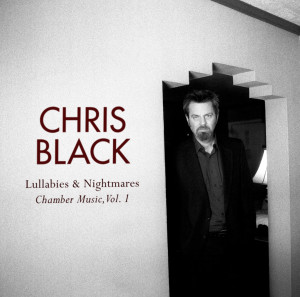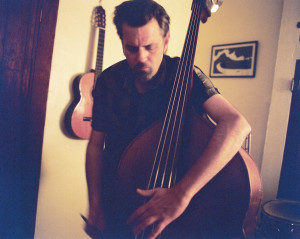Sonic Storytelling

Photo by Shelly Black
Under an August noon, Chris Black handed me his recently pressed CDs, Lullabies & Nightmares: Chamber Music Vol. 1 and Downtown Suite & Cooper Must Die. I told him, “I only know how to write about this based on the vibes I get from the music. I’m not a classically trained musician.” He smiled and said, “That’s okay, neither am I.”
Be that as it may, Black’s recent releases are songs he wrote for ChamberLab – an alt-classical concert series he created over seven years ago to bring “new music to different audiences in strange rooms and from unlikely sources.”
It’s easy to confuse ChamberLab and these Chris Black releases. “ChamberLab, the concert series,” he explains, “is its own thing, and this release is a collection of music which I hope will have a life beyond that. So, it’s not a ChamberLab show – it’s all about good old Chris Black, who wrote a bunch of chamber music, and here it is.”
The “bunch of chamber music” Black refers to is a collection of fascinating tunes, comprised of a captivating conglomeration of notes that weave together mesmerizing tales. It’s sonic storytelling. Through music, Black creates interesting scenes and evokes a wide-range of emotions. To sit with these albums, and close out the world, is endlessly interesting with its compositions performed on instruments that most people aren’t exposed to on a regular basis. When was the last time you could say you really dug how the double bass and bassoon reminded you of a stern buffalo who was trying to impart ancient wisdom that shouldn’t be ignored?
Lullabies & Nightmares is a 15-song soundtrack to the script in your brain. Some tunes are filled with suspense and tension, conveying treachery and darkness; other are upbeat, playful and heartening. Different songs bring forth unique and distinct characters and situations, some are pragmatic and logical, others are insistent, haughty and inquisitive, while a couple of pieces have sections that are tenderly romantic and convey loving sweetness. One of the tracks, which imparted a sense of sneaking along in the dark, brought to mind the book “Where the Wild Things Are.” It’s cerebral entertainment.
The Downtown Suite, as noted on the album sleeve, is “a set of double reed duets inspired by the ever-changing landscape of downtown Tucson,” while Cooper Must Die is a “dense, claustrophobic story for string trio and narrator.”
For the upcoming CD release, “Lullabies and Nightmares will be performed nearly in its entirety,” said Black, “and excerpts from Downtown Suite and Cooper Must Die will be performed as well.
“I’m delighted to say that Gabriel Sullivan (who recorded the albums) will be available that night to perform the narration from Cooper Must Die. This is wonderful news, as he’s awesome, and I can’t play the bass and talk at the same time. Sing, yes, but talk, no. I certainly can’t mutter.”
The CD release is Friday, Sept. 8 at 191 Toole, 191 E. Toole Ave. The $10 concert features the original recording ensembles with members of the Tucson Symphony Orchestra and the Grammy Award-winning True Concord Voices and Orchestra. The musicians are: Mindi Acosta, flute; Cassandra Bendickson, bassoon; Chris Black, double bass; Samantha Bounkeua, violin; Jessica Campbell, bassoon and contrabassoon; Cat Cantrell, oboe and English horn; Anne Gratz, cello; Daniel Hursey, bassoon.
Learn more about all of this at ChrisBlackMusic.com.
Q&A with Chris Black
What drew you to chamber music as a creative outlet? What keeps you interested?

Chris Black
Photo by Shelly Black
Chamber music, as distinct from playing in bands, appeals to me because of the variety of acoustic sounds, from strings to brass to reeds and double reeds, right down to the monstrous contrabassoon. There’s a lot you can do with this that you can’t find in your guitar/bass/drums power trio, no matter how many effects pedals you pile up. Another thing is the incredible skill and musicianship of classical musicians, who can take a piece of music and bring a deep, living performance out of it, often at first sight. They display strengths in areas you don’t find in the non-classical world, just as non-classical performers have strengths in areas that are practically unknown on the other side of the fence. I love to find the places where these strengths overlap, or where they may thrive out of context. This classical/non-classical situation could actually be the subject of a long article in itself, and an interesting one, and one I don’t think I’ve seen in print before. I could go on and on. It’s just a lot of fun.
When did you compose the songs on these albums? How long was the process from writing to recording to the CD release?
These songs have been composed here and there over the last five years. At some point I realized I had accumulated a nice collection of music, and that I had better get it all into the studio before it is lost. The actual sessions in the studio totaled only about ten hours, which is really unbelievably fast for the amount of music involved. These performers are incredibly talented.
I noticed the nightmares are longer than the lullabies.
Yes, that’s true. Nightmares are more my strong suite, historically. The three lullabies surprised most people who know me when I wrote them. They were unaware that I could write pretty music! Also, there is a certain amount of improvisation in the nightmares, which opens up the form a bit. Most of the lullabies and nightmares began their lives as solo bass pieces, which I expanded for the ensemble at hand.
I like how the songs have different stories and vibes. It runs from film noir and suspense to romantic and horror. Are these genres you enjoy in film?
This probably comes from reading more than film, but I do love noir in all its media. I’m on a Raymond Chandler binge right now, for example, and not for the first time. One of my first chamber pieces was a suite of music inspired by characters in James Ellroy novels. In general, and I’m not sure why, I have always written music that seems to set some sort of scene, and those scenes have most often been darker, dirtier, and maybe a little bent.
Cooper Must Die has this Kafka, David Lynch vibe. What inspired that piece?
As grim as it seems, this piece was a straightforward effort to portray what it felt like to be me. I wanted to write a soundtrack for my inner life, and I wanted others to be able to hear it and understand. I think I succeeded. It was a bad breakup that lingered for a long time. I’m happy to say that I’m better, and my inner life is much, much brighter these days. Cooper’s okay. Everyone’s okay.
What inspired these songs?
Bassoon Trios
The first three musicians who joined us after the first ChamberLab concert were all bassoonists, and a friend of mine suggested that bassoon trios would be very popular, so I wrote them, and they were!
Lullabies & Nightmares
My wife and I were listening to the radio, and they just played a lullaby by maybe Brahms or someone, and I said, “No one writes lullabies anymore, ” and my wife said, “You should!” So I did, and I added the nightmares because that’s how I roll.
Back to Bed and You Are Alone
These are both pieces from an in-progress Choose-You-Own-Adventure suite called Everything Happens for a Reason, where the listener makes decisions that lead to the next song. We had a  trial run of it a few years back, which you can see here.
trial run of it a few years back, which you can see here.
Downtown Suite
This was a piece commissioned by the Kontra-Cor Duo in 2012. It’s a set of scenes from Tucson’s downtown, along Congress St. between Wig-O-Rama and the Hotel Congress, from sunrise to sunset. The real-life inspiration for the music is given in each title. The online album cover is a photo I took of the curb outside the Red Room/Grill after the fire.
Trio
This is my favorite thing I’ve ever written.
Category: MUSIC




